Cross-Cultural Management, Hofstede, and Hospitality Success
VerifiedAdded on 2021/02/21
|13
|2650
|48
Report
AI Summary
This report delves into the significance of cross-cultural management within the hospitality industry, emphasizing the need for understanding cultural differences, preferences, and practices. It highlights the benefits and challenges faced by hospitality organizations like Hilton Hotel, which operates globally with diverse customer bases and staff. The report discusses the role of cultural understanding in enhancing service quality, improving communication, and fostering effective teamwork. It also explores how Hofstede's six-dimensional model aids in managing cultural diversity, providing insights into power distance, uncertainty avoidance, individualism, collectivism, indulgence, and long-term orientation. The report concludes that effective cross-cultural management is crucial for success in the hospitality sector, enabling organizations to address cultural conflicts, improve team performance, and achieve customer satisfaction.
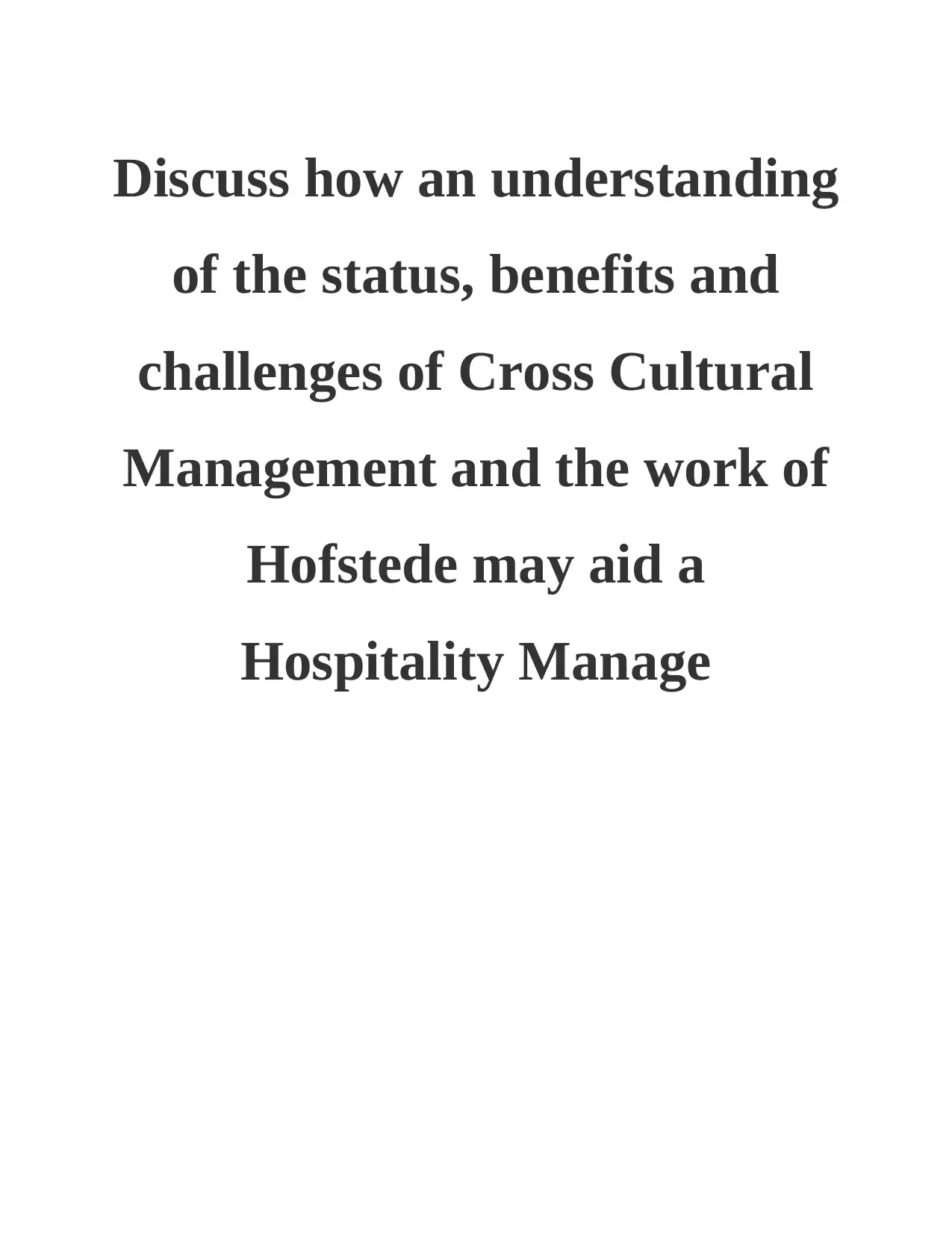
Discuss how an understanding
of the status, benefits and
challenges of Cross Cultural
Management and the work of
Hofstede may aid a
Hospitality Manage
of the status, benefits and
challenges of Cross Cultural
Management and the work of
Hofstede may aid a
Hospitality Manage
Paraphrase This Document
Need a fresh take? Get an instant paraphrase of this document with our AI Paraphraser
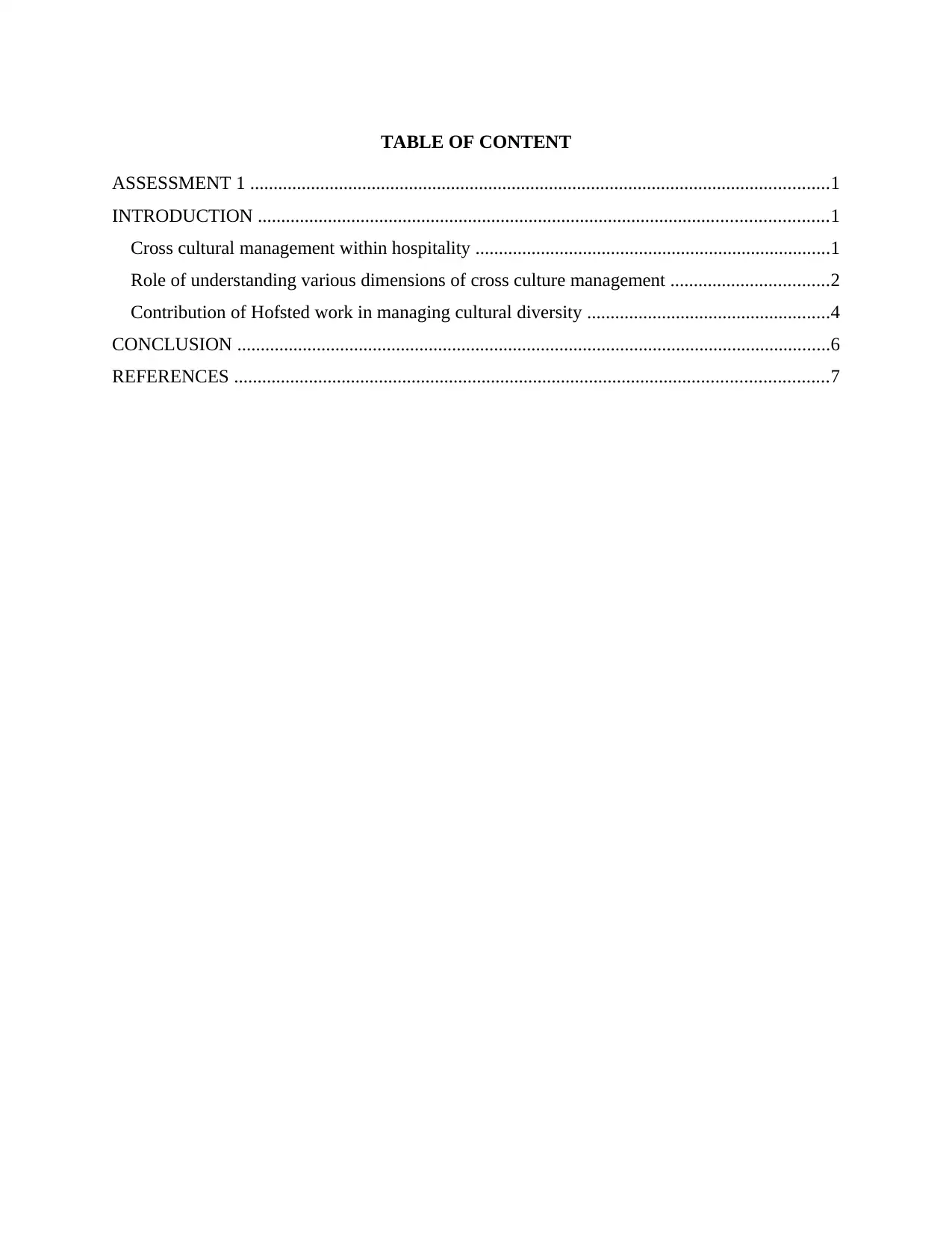
TABLE OF CONTENT
ASSESSMENT 1 ............................................................................................................................1
INTRODUCTION ..........................................................................................................................1
Cross cultural management within hospitality ............................................................................1
Role of understanding various dimensions of cross culture management ..................................2
Contribution of Hofsted work in managing cultural diversity ....................................................4
CONCLUSION ...............................................................................................................................6
REFERENCES ...............................................................................................................................7
ASSESSMENT 1 ............................................................................................................................1
INTRODUCTION ..........................................................................................................................1
Cross cultural management within hospitality ............................................................................1
Role of understanding various dimensions of cross culture management ..................................2
Contribution of Hofsted work in managing cultural diversity ....................................................4
CONCLUSION ...............................................................................................................................6
REFERENCES ...............................................................................................................................7
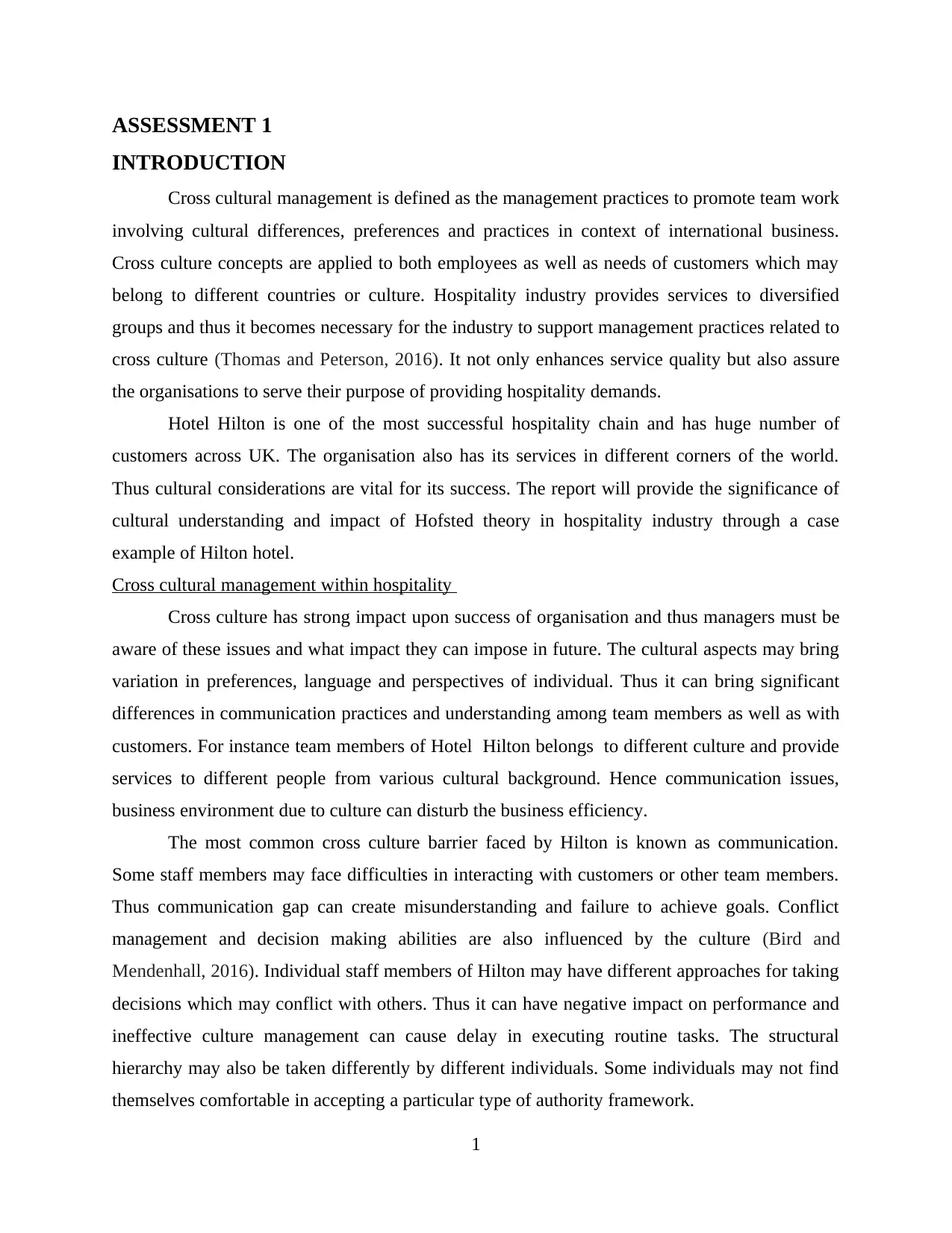
ASSESSMENT 1
INTRODUCTION
Cross cultural management is defined as the management practices to promote team work
involving cultural differences, preferences and practices in context of international business.
Cross culture concepts are applied to both employees as well as needs of customers which may
belong to different countries or culture. Hospitality industry provides services to diversified
groups and thus it becomes necessary for the industry to support management practices related to
cross culture (Thomas and Peterson, 2016). It not only enhances service quality but also assure
the organisations to serve their purpose of providing hospitality demands.
Hotel Hilton is one of the most successful hospitality chain and has huge number of
customers across UK. The organisation also has its services in different corners of the world.
Thus cultural considerations are vital for its success. The report will provide the significance of
cultural understanding and impact of Hofsted theory in hospitality industry through a case
example of Hilton hotel.
Cross cultural management within hospitality
Cross culture has strong impact upon success of organisation and thus managers must be
aware of these issues and what impact they can impose in future. The cultural aspects may bring
variation in preferences, language and perspectives of individual. Thus it can bring significant
differences in communication practices and understanding among team members as well as with
customers. For instance team members of Hotel Hilton belongs to different culture and provide
services to different people from various cultural background. Hence communication issues,
business environment due to culture can disturb the business efficiency.
The most common cross culture barrier faced by Hilton is known as communication.
Some staff members may face difficulties in interacting with customers or other team members.
Thus communication gap can create misunderstanding and failure to achieve goals. Conflict
management and decision making abilities are also influenced by the culture (Bird and
Mendenhall, 2016). Individual staff members of Hilton may have different approaches for taking
decisions which may conflict with others. Thus it can have negative impact on performance and
ineffective culture management can cause delay in executing routine tasks. The structural
hierarchy may also be taken differently by different individuals. Some individuals may not find
themselves comfortable in accepting a particular type of authority framework.
1
INTRODUCTION
Cross cultural management is defined as the management practices to promote team work
involving cultural differences, preferences and practices in context of international business.
Cross culture concepts are applied to both employees as well as needs of customers which may
belong to different countries or culture. Hospitality industry provides services to diversified
groups and thus it becomes necessary for the industry to support management practices related to
cross culture (Thomas and Peterson, 2016). It not only enhances service quality but also assure
the organisations to serve their purpose of providing hospitality demands.
Hotel Hilton is one of the most successful hospitality chain and has huge number of
customers across UK. The organisation also has its services in different corners of the world.
Thus cultural considerations are vital for its success. The report will provide the significance of
cultural understanding and impact of Hofsted theory in hospitality industry through a case
example of Hilton hotel.
Cross cultural management within hospitality
Cross culture has strong impact upon success of organisation and thus managers must be
aware of these issues and what impact they can impose in future. The cultural aspects may bring
variation in preferences, language and perspectives of individual. Thus it can bring significant
differences in communication practices and understanding among team members as well as with
customers. For instance team members of Hotel Hilton belongs to different culture and provide
services to different people from various cultural background. Hence communication issues,
business environment due to culture can disturb the business efficiency.
The most common cross culture barrier faced by Hilton is known as communication.
Some staff members may face difficulties in interacting with customers or other team members.
Thus communication gap can create misunderstanding and failure to achieve goals. Conflict
management and decision making abilities are also influenced by the culture (Bird and
Mendenhall, 2016). Individual staff members of Hilton may have different approaches for taking
decisions which may conflict with others. Thus it can have negative impact on performance and
ineffective culture management can cause delay in executing routine tasks. The structural
hierarchy may also be taken differently by different individuals. Some individuals may not find
themselves comfortable in accepting a particular type of authority framework.
1
⊘ This is a preview!⊘
Do you want full access?
Subscribe today to unlock all pages.

Trusted by 1+ million students worldwide
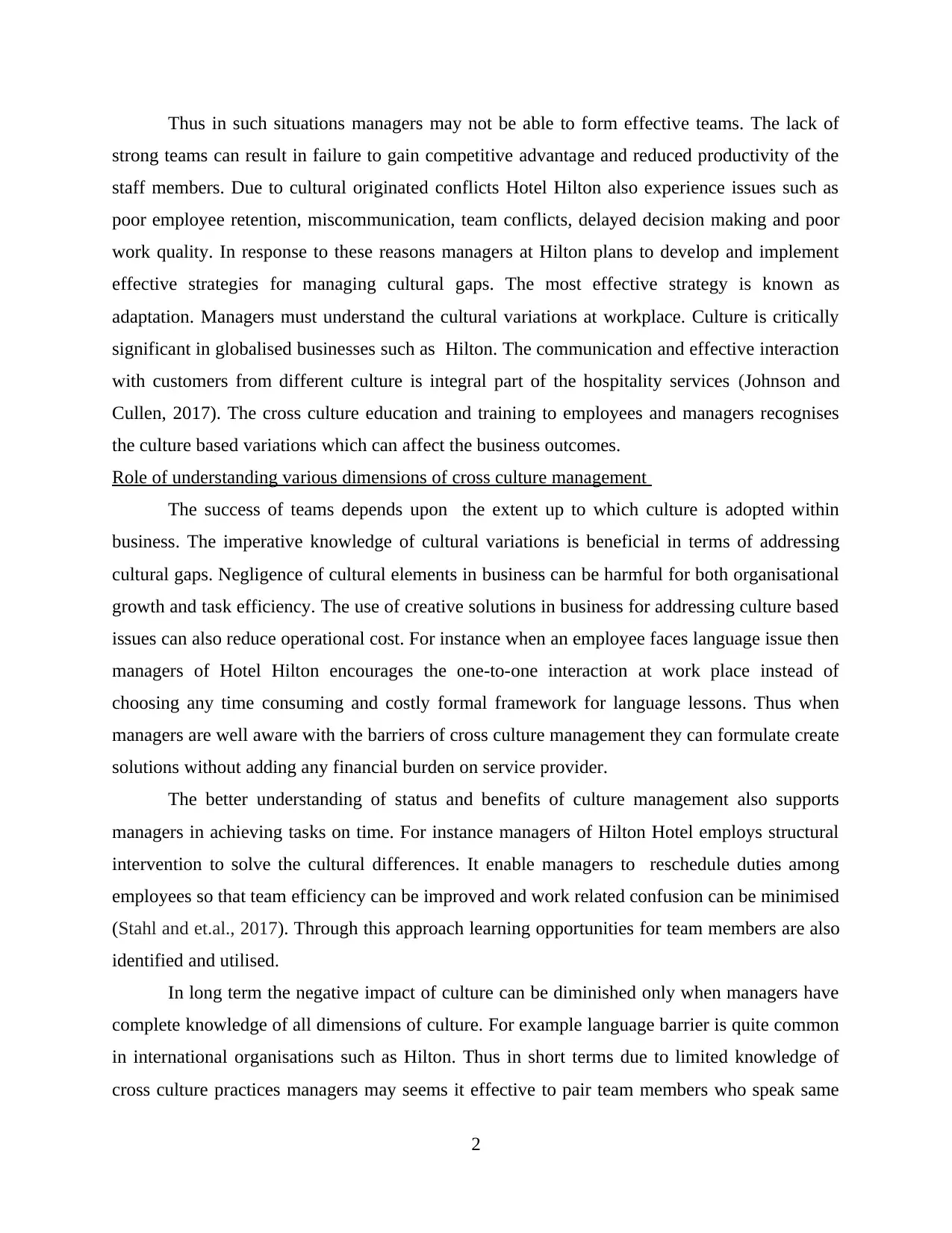
Thus in such situations managers may not be able to form effective teams. The lack of
strong teams can result in failure to gain competitive advantage and reduced productivity of the
staff members. Due to cultural originated conflicts Hotel Hilton also experience issues such as
poor employee retention, miscommunication, team conflicts, delayed decision making and poor
work quality. In response to these reasons managers at Hilton plans to develop and implement
effective strategies for managing cultural gaps. The most effective strategy is known as
adaptation. Managers must understand the cultural variations at workplace. Culture is critically
significant in globalised businesses such as Hilton. The communication and effective interaction
with customers from different culture is integral part of the hospitality services (Johnson and
Cullen, 2017). The cross culture education and training to employees and managers recognises
the culture based variations which can affect the business outcomes.
Role of understanding various dimensions of cross culture management
The success of teams depends upon the extent up to which culture is adopted within
business. The imperative knowledge of cultural variations is beneficial in terms of addressing
cultural gaps. Negligence of cultural elements in business can be harmful for both organisational
growth and task efficiency. The use of creative solutions in business for addressing culture based
issues can also reduce operational cost. For instance when an employee faces language issue then
managers of Hotel Hilton encourages the one-to-one interaction at work place instead of
choosing any time consuming and costly formal framework for language lessons. Thus when
managers are well aware with the barriers of cross culture management they can formulate create
solutions without adding any financial burden on service provider.
The better understanding of status and benefits of culture management also supports
managers in achieving tasks on time. For instance managers of Hilton Hotel employs structural
intervention to solve the cultural differences. It enable managers to reschedule duties among
employees so that team efficiency can be improved and work related confusion can be minimised
(Stahl and et.al., 2017). Through this approach learning opportunities for team members are also
identified and utilised.
In long term the negative impact of culture can be diminished only when managers have
complete knowledge of all dimensions of culture. For example language barrier is quite common
in international organisations such as Hilton. Thus in short terms due to limited knowledge of
cross culture practices managers may seems it effective to pair team members who speak same
2
strong teams can result in failure to gain competitive advantage and reduced productivity of the
staff members. Due to cultural originated conflicts Hotel Hilton also experience issues such as
poor employee retention, miscommunication, team conflicts, delayed decision making and poor
work quality. In response to these reasons managers at Hilton plans to develop and implement
effective strategies for managing cultural gaps. The most effective strategy is known as
adaptation. Managers must understand the cultural variations at workplace. Culture is critically
significant in globalised businesses such as Hilton. The communication and effective interaction
with customers from different culture is integral part of the hospitality services (Johnson and
Cullen, 2017). The cross culture education and training to employees and managers recognises
the culture based variations which can affect the business outcomes.
Role of understanding various dimensions of cross culture management
The success of teams depends upon the extent up to which culture is adopted within
business. The imperative knowledge of cultural variations is beneficial in terms of addressing
cultural gaps. Negligence of cultural elements in business can be harmful for both organisational
growth and task efficiency. The use of creative solutions in business for addressing culture based
issues can also reduce operational cost. For instance when an employee faces language issue then
managers of Hotel Hilton encourages the one-to-one interaction at work place instead of
choosing any time consuming and costly formal framework for language lessons. Thus when
managers are well aware with the barriers of cross culture management they can formulate create
solutions without adding any financial burden on service provider.
The better understanding of status and benefits of culture management also supports
managers in achieving tasks on time. For instance managers of Hilton Hotel employs structural
intervention to solve the cultural differences. It enable managers to reschedule duties among
employees so that team efficiency can be improved and work related confusion can be minimised
(Stahl and et.al., 2017). Through this approach learning opportunities for team members are also
identified and utilised.
In long term the negative impact of culture can be diminished only when managers have
complete knowledge of all dimensions of culture. For example language barrier is quite common
in international organisations such as Hilton. Thus in short terms due to limited knowledge of
cross culture practices managers may seems it effective to pair team members who speak same
2
Paraphrase This Document
Need a fresh take? Get an instant paraphrase of this document with our AI Paraphraser
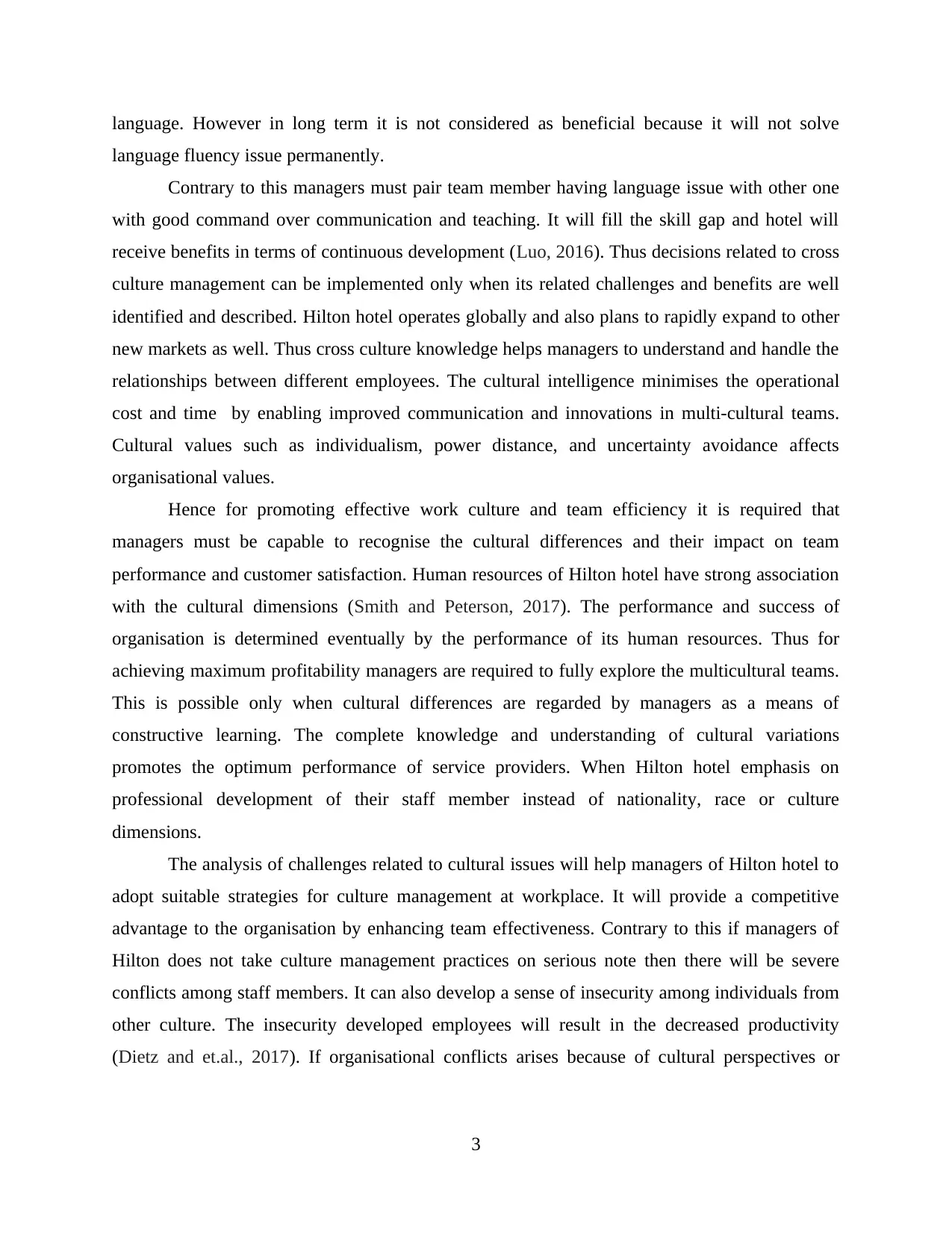
language. However in long term it is not considered as beneficial because it will not solve
language fluency issue permanently.
Contrary to this managers must pair team member having language issue with other one
with good command over communication and teaching. It will fill the skill gap and hotel will
receive benefits in terms of continuous development (Luo, 2016). Thus decisions related to cross
culture management can be implemented only when its related challenges and benefits are well
identified and described. Hilton hotel operates globally and also plans to rapidly expand to other
new markets as well. Thus cross culture knowledge helps managers to understand and handle the
relationships between different employees. The cultural intelligence minimises the operational
cost and time by enabling improved communication and innovations in multi-cultural teams.
Cultural values such as individualism, power distance, and uncertainty avoidance affects
organisational values.
Hence for promoting effective work culture and team efficiency it is required that
managers must be capable to recognise the cultural differences and their impact on team
performance and customer satisfaction. Human resources of Hilton hotel have strong association
with the cultural dimensions (Smith and Peterson, 2017). The performance and success of
organisation is determined eventually by the performance of its human resources. Thus for
achieving maximum profitability managers are required to fully explore the multicultural teams.
This is possible only when cultural differences are regarded by managers as a means of
constructive learning. The complete knowledge and understanding of cultural variations
promotes the optimum performance of service providers. When Hilton hotel emphasis on
professional development of their staff member instead of nationality, race or culture
dimensions.
The analysis of challenges related to cultural issues will help managers of Hilton hotel to
adopt suitable strategies for culture management at workplace. It will provide a competitive
advantage to the organisation by enhancing team effectiveness. Contrary to this if managers of
Hilton does not take culture management practices on serious note then there will be severe
conflicts among staff members. It can also develop a sense of insecurity among individuals from
other culture. The insecurity developed employees will result in the decreased productivity
(Dietz and et.al., 2017). If organisational conflicts arises because of cultural perspectives or
3
language fluency issue permanently.
Contrary to this managers must pair team member having language issue with other one
with good command over communication and teaching. It will fill the skill gap and hotel will
receive benefits in terms of continuous development (Luo, 2016). Thus decisions related to cross
culture management can be implemented only when its related challenges and benefits are well
identified and described. Hilton hotel operates globally and also plans to rapidly expand to other
new markets as well. Thus cross culture knowledge helps managers to understand and handle the
relationships between different employees. The cultural intelligence minimises the operational
cost and time by enabling improved communication and innovations in multi-cultural teams.
Cultural values such as individualism, power distance, and uncertainty avoidance affects
organisational values.
Hence for promoting effective work culture and team efficiency it is required that
managers must be capable to recognise the cultural differences and their impact on team
performance and customer satisfaction. Human resources of Hilton hotel have strong association
with the cultural dimensions (Smith and Peterson, 2017). The performance and success of
organisation is determined eventually by the performance of its human resources. Thus for
achieving maximum profitability managers are required to fully explore the multicultural teams.
This is possible only when cultural differences are regarded by managers as a means of
constructive learning. The complete knowledge and understanding of cultural variations
promotes the optimum performance of service providers. When Hilton hotel emphasis on
professional development of their staff member instead of nationality, race or culture
dimensions.
The analysis of challenges related to cultural issues will help managers of Hilton hotel to
adopt suitable strategies for culture management at workplace. It will provide a competitive
advantage to the organisation by enhancing team effectiveness. Contrary to this if managers of
Hilton does not take culture management practices on serious note then there will be severe
conflicts among staff members. It can also develop a sense of insecurity among individuals from
other culture. The insecurity developed employees will result in the decreased productivity
(Dietz and et.al., 2017). If organisational conflicts arises because of cultural perspectives or
3
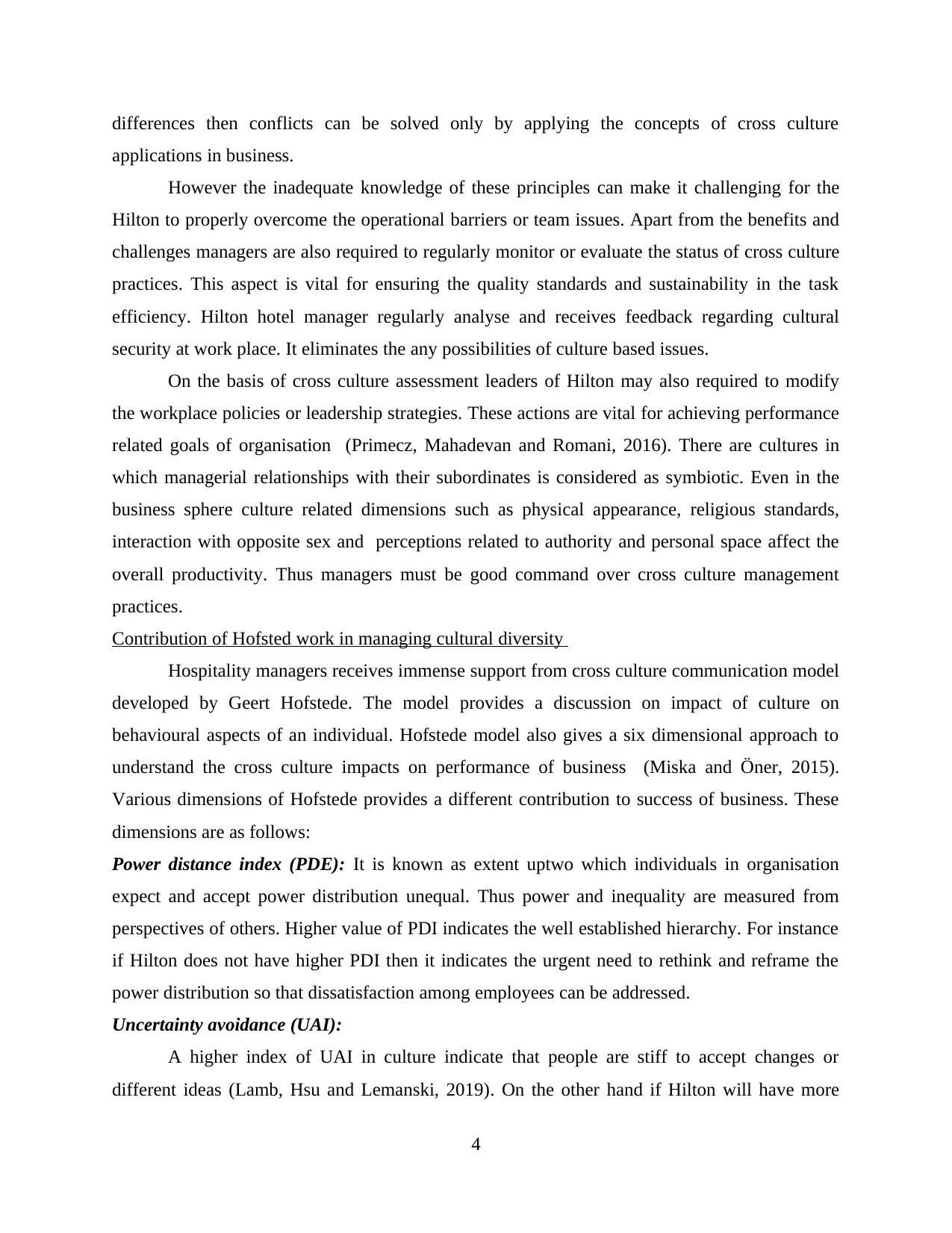
differences then conflicts can be solved only by applying the concepts of cross culture
applications in business.
However the inadequate knowledge of these principles can make it challenging for the
Hilton to properly overcome the operational barriers or team issues. Apart from the benefits and
challenges managers are also required to regularly monitor or evaluate the status of cross culture
practices. This aspect is vital for ensuring the quality standards and sustainability in the task
efficiency. Hilton hotel manager regularly analyse and receives feedback regarding cultural
security at work place. It eliminates the any possibilities of culture based issues.
On the basis of cross culture assessment leaders of Hilton may also required to modify
the workplace policies or leadership strategies. These actions are vital for achieving performance
related goals of organisation (Primecz, Mahadevan and Romani, 2016). There are cultures in
which managerial relationships with their subordinates is considered as symbiotic. Even in the
business sphere culture related dimensions such as physical appearance, religious standards,
interaction with opposite sex and perceptions related to authority and personal space affect the
overall productivity. Thus managers must be good command over cross culture management
practices.
Contribution of Hofsted work in managing cultural diversity
Hospitality managers receives immense support from cross culture communication model
developed by Geert Hofstede. The model provides a discussion on impact of culture on
behavioural aspects of an individual. Hofstede model also gives a six dimensional approach to
understand the cross culture impacts on performance of business (Miska and Öner, 2015).
Various dimensions of Hofstede provides a different contribution to success of business. These
dimensions are as follows:
Power distance index (PDE): It is known as extent uptwo which individuals in organisation
expect and accept power distribution unequal. Thus power and inequality are measured from
perspectives of others. Higher value of PDI indicates the well established hierarchy. For instance
if Hilton does not have higher PDI then it indicates the urgent need to rethink and reframe the
power distribution so that dissatisfaction among employees can be addressed.
Uncertainty avoidance (UAI):
A higher index of UAI in culture indicate that people are stiff to accept changes or
different ideas (Lamb, Hsu and Lemanski, 2019). On the other hand if Hilton will have more
4
applications in business.
However the inadequate knowledge of these principles can make it challenging for the
Hilton to properly overcome the operational barriers or team issues. Apart from the benefits and
challenges managers are also required to regularly monitor or evaluate the status of cross culture
practices. This aspect is vital for ensuring the quality standards and sustainability in the task
efficiency. Hilton hotel manager regularly analyse and receives feedback regarding cultural
security at work place. It eliminates the any possibilities of culture based issues.
On the basis of cross culture assessment leaders of Hilton may also required to modify
the workplace policies or leadership strategies. These actions are vital for achieving performance
related goals of organisation (Primecz, Mahadevan and Romani, 2016). There are cultures in
which managerial relationships with their subordinates is considered as symbiotic. Even in the
business sphere culture related dimensions such as physical appearance, religious standards,
interaction with opposite sex and perceptions related to authority and personal space affect the
overall productivity. Thus managers must be good command over cross culture management
practices.
Contribution of Hofsted work in managing cultural diversity
Hospitality managers receives immense support from cross culture communication model
developed by Geert Hofstede. The model provides a discussion on impact of culture on
behavioural aspects of an individual. Hofstede model also gives a six dimensional approach to
understand the cross culture impacts on performance of business (Miska and Öner, 2015).
Various dimensions of Hofstede provides a different contribution to success of business. These
dimensions are as follows:
Power distance index (PDE): It is known as extent uptwo which individuals in organisation
expect and accept power distribution unequal. Thus power and inequality are measured from
perspectives of others. Higher value of PDI indicates the well established hierarchy. For instance
if Hilton does not have higher PDI then it indicates the urgent need to rethink and reframe the
power distribution so that dissatisfaction among employees can be addressed.
Uncertainty avoidance (UAI):
A higher index of UAI in culture indicate that people are stiff to accept changes or
different ideas (Lamb, Hsu and Lemanski, 2019). On the other hand if Hilton will have more
4
⊘ This is a preview!⊘
Do you want full access?
Subscribe today to unlock all pages.

Trusted by 1+ million students worldwide
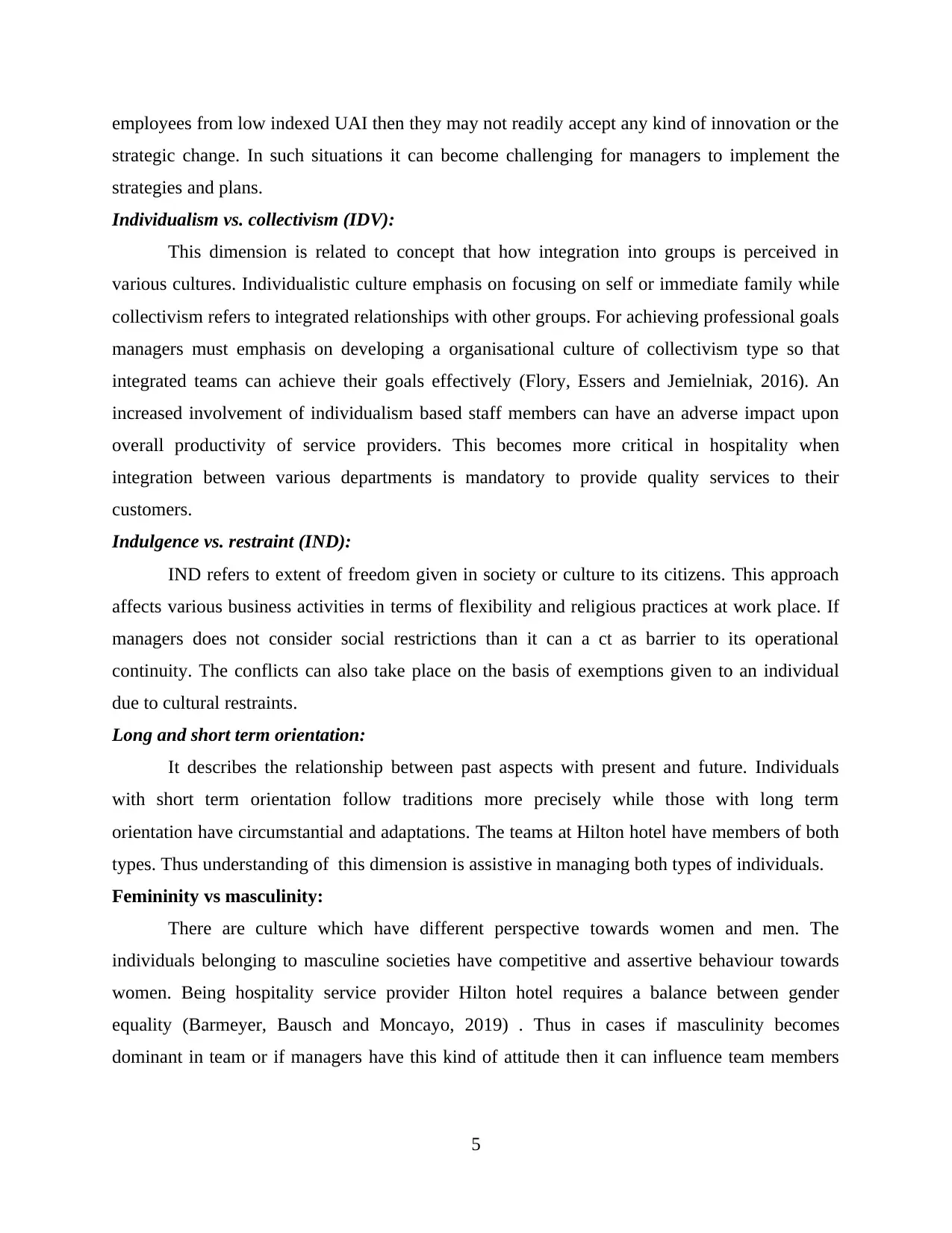
employees from low indexed UAI then they may not readily accept any kind of innovation or the
strategic change. In such situations it can become challenging for managers to implement the
strategies and plans.
Individualism vs. collectivism (IDV):
This dimension is related to concept that how integration into groups is perceived in
various cultures. Individualistic culture emphasis on focusing on self or immediate family while
collectivism refers to integrated relationships with other groups. For achieving professional goals
managers must emphasis on developing a organisational culture of collectivism type so that
integrated teams can achieve their goals effectively (Flory, Essers and Jemielniak, 2016). An
increased involvement of individualism based staff members can have an adverse impact upon
overall productivity of service providers. This becomes more critical in hospitality when
integration between various departments is mandatory to provide quality services to their
customers.
Indulgence vs. restraint (IND):
IND refers to extent of freedom given in society or culture to its citizens. This approach
affects various business activities in terms of flexibility and religious practices at work place. If
managers does not consider social restrictions than it can a ct as barrier to its operational
continuity. The conflicts can also take place on the basis of exemptions given to an individual
due to cultural restraints.
Long and short term orientation:
It describes the relationship between past aspects with present and future. Individuals
with short term orientation follow traditions more precisely while those with long term
orientation have circumstantial and adaptations. The teams at Hilton hotel have members of both
types. Thus understanding of this dimension is assistive in managing both types of individuals.
Femininity vs masculinity:
There are culture which have different perspective towards women and men. The
individuals belonging to masculine societies have competitive and assertive behaviour towards
women. Being hospitality service provider Hilton hotel requires a balance between gender
equality (Barmeyer, Bausch and Moncayo, 2019) . Thus in cases if masculinity becomes
dominant in team or if managers have this kind of attitude then it can influence team members
5
strategic change. In such situations it can become challenging for managers to implement the
strategies and plans.
Individualism vs. collectivism (IDV):
This dimension is related to concept that how integration into groups is perceived in
various cultures. Individualistic culture emphasis on focusing on self or immediate family while
collectivism refers to integrated relationships with other groups. For achieving professional goals
managers must emphasis on developing a organisational culture of collectivism type so that
integrated teams can achieve their goals effectively (Flory, Essers and Jemielniak, 2016). An
increased involvement of individualism based staff members can have an adverse impact upon
overall productivity of service providers. This becomes more critical in hospitality when
integration between various departments is mandatory to provide quality services to their
customers.
Indulgence vs. restraint (IND):
IND refers to extent of freedom given in society or culture to its citizens. This approach
affects various business activities in terms of flexibility and religious practices at work place. If
managers does not consider social restrictions than it can a ct as barrier to its operational
continuity. The conflicts can also take place on the basis of exemptions given to an individual
due to cultural restraints.
Long and short term orientation:
It describes the relationship between past aspects with present and future. Individuals
with short term orientation follow traditions more precisely while those with long term
orientation have circumstantial and adaptations. The teams at Hilton hotel have members of both
types. Thus understanding of this dimension is assistive in managing both types of individuals.
Femininity vs masculinity:
There are culture which have different perspective towards women and men. The
individuals belonging to masculine societies have competitive and assertive behaviour towards
women. Being hospitality service provider Hilton hotel requires a balance between gender
equality (Barmeyer, Bausch and Moncayo, 2019) . Thus in cases if masculinity becomes
dominant in team or if managers have this kind of attitude then it can influence team members
5
Paraphrase This Document
Need a fresh take? Get an instant paraphrase of this document with our AI Paraphraser
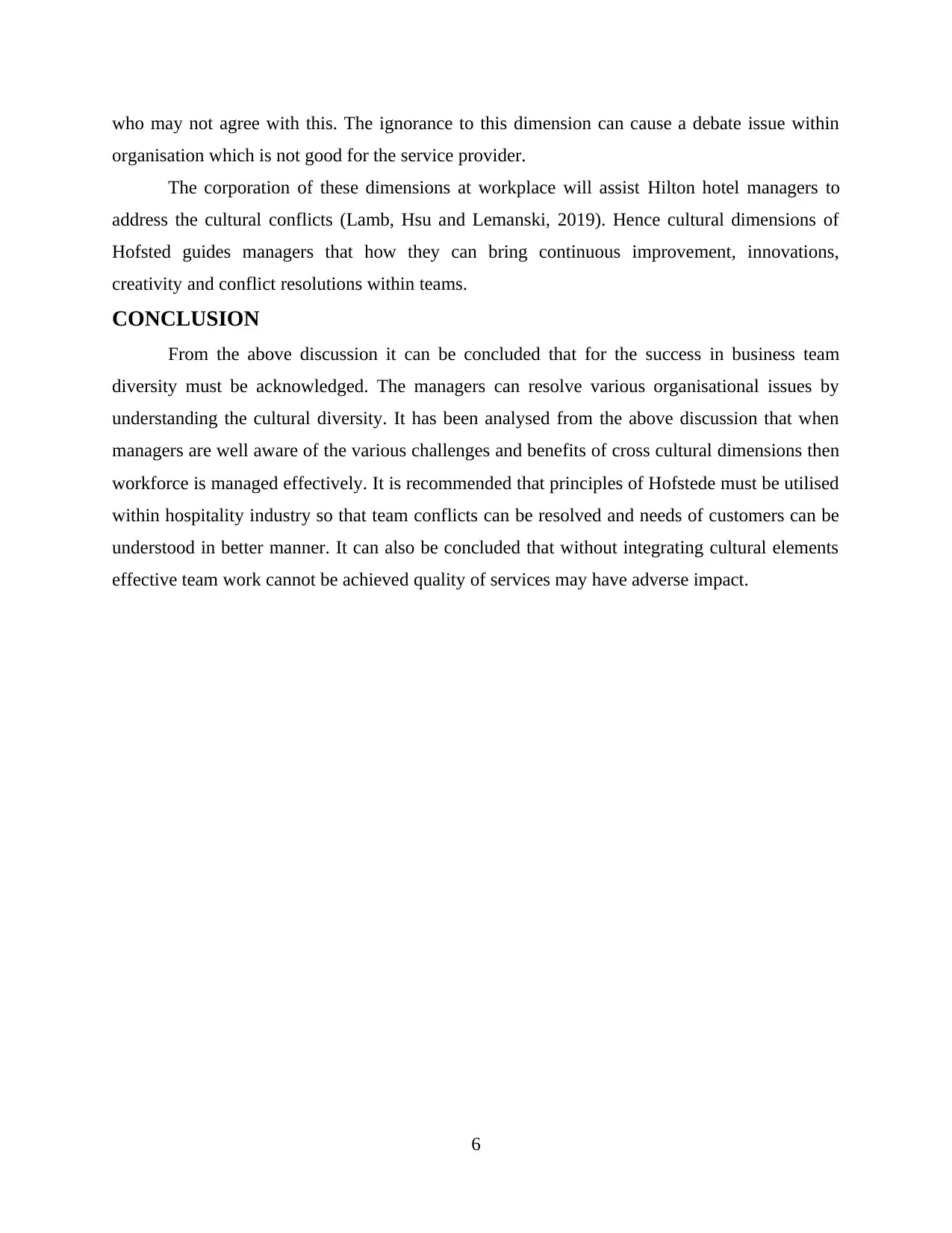
who may not agree with this. The ignorance to this dimension can cause a debate issue within
organisation which is not good for the service provider.
The corporation of these dimensions at workplace will assist Hilton hotel managers to
address the cultural conflicts (Lamb, Hsu and Lemanski, 2019). Hence cultural dimensions of
Hofsted guides managers that how they can bring continuous improvement, innovations,
creativity and conflict resolutions within teams.
CONCLUSION
From the above discussion it can be concluded that for the success in business team
diversity must be acknowledged. The managers can resolve various organisational issues by
understanding the cultural diversity. It has been analysed from the above discussion that when
managers are well aware of the various challenges and benefits of cross cultural dimensions then
workforce is managed effectively. It is recommended that principles of Hofstede must be utilised
within hospitality industry so that team conflicts can be resolved and needs of customers can be
understood in better manner. It can also be concluded that without integrating cultural elements
effective team work cannot be achieved quality of services may have adverse impact.
6
organisation which is not good for the service provider.
The corporation of these dimensions at workplace will assist Hilton hotel managers to
address the cultural conflicts (Lamb, Hsu and Lemanski, 2019). Hence cultural dimensions of
Hofsted guides managers that how they can bring continuous improvement, innovations,
creativity and conflict resolutions within teams.
CONCLUSION
From the above discussion it can be concluded that for the success in business team
diversity must be acknowledged. The managers can resolve various organisational issues by
understanding the cultural diversity. It has been analysed from the above discussion that when
managers are well aware of the various challenges and benefits of cross cultural dimensions then
workforce is managed effectively. It is recommended that principles of Hofstede must be utilised
within hospitality industry so that team conflicts can be resolved and needs of customers can be
understood in better manner. It can also be concluded that without integrating cultural elements
effective team work cannot be achieved quality of services may have adverse impact.
6
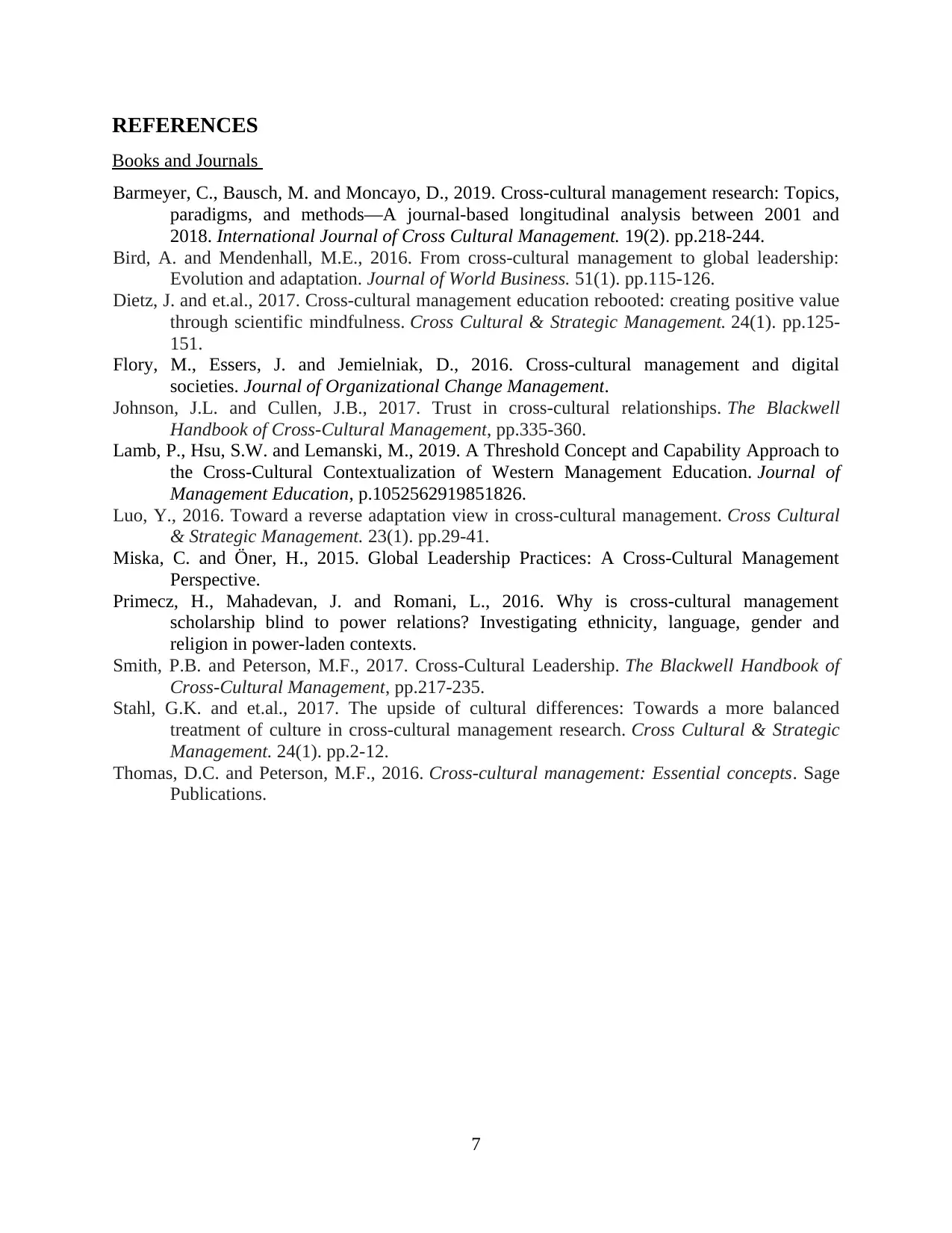
REFERENCES
Books and Journals
Barmeyer, C., Bausch, M. and Moncayo, D., 2019. Cross-cultural management research: Topics,
paradigms, and methods—A journal-based longitudinal analysis between 2001 and
2018. International Journal of Cross Cultural Management. 19(2). pp.218-244.
Bird, A. and Mendenhall, M.E., 2016. From cross-cultural management to global leadership:
Evolution and adaptation. Journal of World Business. 51(1). pp.115-126.
Dietz, J. and et.al., 2017. Cross-cultural management education rebooted: creating positive value
through scientific mindfulness. Cross Cultural & Strategic Management. 24(1). pp.125-
151.
Flory, M., Essers, J. and Jemielniak, D., 2016. Cross-cultural management and digital
societies. Journal of Organizational Change Management.
Johnson, J.L. and Cullen, J.B., 2017. Trust in cross‐cultural relationships. The Blackwell
Handbook of Cross‐Cultural Management, pp.335-360.
Lamb, P., Hsu, S.W. and Lemanski, M., 2019. A Threshold Concept and Capability Approach to
the Cross-Cultural Contextualization of Western Management Education. Journal of
Management Education, p.1052562919851826.
Luo, Y., 2016. Toward a reverse adaptation view in cross-cultural management. Cross Cultural
& Strategic Management. 23(1). pp.29-41.
Miska, C. and Öner, H., 2015. Global Leadership Practices: A Cross-Cultural Management
Perspective.
Primecz, H., Mahadevan, J. and Romani, L., 2016. Why is cross-cultural management
scholarship blind to power relations? Investigating ethnicity, language, gender and
religion in power-laden contexts.
Smith, P.B. and Peterson, M.F., 2017. Cross‐Cultural Leadership. The Blackwell Handbook of
Cross‐Cultural Management, pp.217-235.
Stahl, G.K. and et.al., 2017. The upside of cultural differences: Towards a more balanced
treatment of culture in cross-cultural management research. Cross Cultural & Strategic
Management. 24(1). pp.2-12.
Thomas, D.C. and Peterson, M.F., 2016. Cross-cultural management: Essential concepts. Sage
Publications.
7
Books and Journals
Barmeyer, C., Bausch, M. and Moncayo, D., 2019. Cross-cultural management research: Topics,
paradigms, and methods—A journal-based longitudinal analysis between 2001 and
2018. International Journal of Cross Cultural Management. 19(2). pp.218-244.
Bird, A. and Mendenhall, M.E., 2016. From cross-cultural management to global leadership:
Evolution and adaptation. Journal of World Business. 51(1). pp.115-126.
Dietz, J. and et.al., 2017. Cross-cultural management education rebooted: creating positive value
through scientific mindfulness. Cross Cultural & Strategic Management. 24(1). pp.125-
151.
Flory, M., Essers, J. and Jemielniak, D., 2016. Cross-cultural management and digital
societies. Journal of Organizational Change Management.
Johnson, J.L. and Cullen, J.B., 2017. Trust in cross‐cultural relationships. The Blackwell
Handbook of Cross‐Cultural Management, pp.335-360.
Lamb, P., Hsu, S.W. and Lemanski, M., 2019. A Threshold Concept and Capability Approach to
the Cross-Cultural Contextualization of Western Management Education. Journal of
Management Education, p.1052562919851826.
Luo, Y., 2016. Toward a reverse adaptation view in cross-cultural management. Cross Cultural
& Strategic Management. 23(1). pp.29-41.
Miska, C. and Öner, H., 2015. Global Leadership Practices: A Cross-Cultural Management
Perspective.
Primecz, H., Mahadevan, J. and Romani, L., 2016. Why is cross-cultural management
scholarship blind to power relations? Investigating ethnicity, language, gender and
religion in power-laden contexts.
Smith, P.B. and Peterson, M.F., 2017. Cross‐Cultural Leadership. The Blackwell Handbook of
Cross‐Cultural Management, pp.217-235.
Stahl, G.K. and et.al., 2017. The upside of cultural differences: Towards a more balanced
treatment of culture in cross-cultural management research. Cross Cultural & Strategic
Management. 24(1). pp.2-12.
Thomas, D.C. and Peterson, M.F., 2016. Cross-cultural management: Essential concepts. Sage
Publications.
7
⊘ This is a preview!⊘
Do you want full access?
Subscribe today to unlock all pages.

Trusted by 1+ million students worldwide

8
Paraphrase This Document
Need a fresh take? Get an instant paraphrase of this document with our AI Paraphraser

9

10
⊘ This is a preview!⊘
Do you want full access?
Subscribe today to unlock all pages.

Trusted by 1+ million students worldwide
1 out of 13
Related Documents
Your All-in-One AI-Powered Toolkit for Academic Success.
+13062052269
info@desklib.com
Available 24*7 on WhatsApp / Email
![[object Object]](/_next/static/media/star-bottom.7253800d.svg)
Unlock your academic potential
Copyright © 2020–2025 A2Z Services. All Rights Reserved. Developed and managed by ZUCOL.





